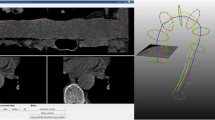Abstract
Purpose
Abnormalities of aortic surface and aortic diameter can be related to cardiovascular disease and aortic aneurysm. Computer-based aortic segmentation and measurement may aid physicians in related disease diagnosis. This paper presents a fully automated algorithm for aorta segmentation in low-dose non-contrast CT images.
Methods
The original non-contrast CT scan images as well as their pre-computed anatomy label maps are used to locate the aorta and identify its surface. First a seed point is located inside the aortic lumen. Then, a cylindrical model is progressively fitted to the 3D image space to track the aorta centerline. Finally, the aortic surface is located based on image intensity information. This algorithm has been trained and tested on 359 low-dose non-contrast CT images from VIA-ELCAP and LIDC public image databases. Twenty images were used for training to obtain the optimal set of parameters, while the remaining images were used for testing. The segmentation result has been evaluated both qualitatively and quantitatively. Sixty representative testing images were used to establish a partial ground truth by manual marking on several axial image slices.
Results
Compared to ground truth marking, the segmentation result had a mean Dice Similarity Coefficient of 0.933 (maximum 0.963 and minimum 0.907). The average boundary distance between manual segmentation and automatic segmentation was 1.39 mm with a maximum of 1.79 mm and a minimum of 0.83 mm.
Conclusion
Both qualitative and quantitative evaluations have shown that the presented algorithm is able to accurately segment the aorta in low-dose non-contrast CT images.








Similar content being viewed by others

References
Schwartz S, Taljanovic M, Smyth S, O’Brien M, Rogers L (2007) CT findings of rupture, impending rupture, and contained rupture of abdominal aortic aneurysms. Am J Roentgenol 188(1):57–62
Hu S, Hoffman EA, Reinhardt JM (2001) Automatic lung segmentation for accurate quantitation of volumetric X-ray CT images. IEEE Trans Med Imaging 20:490–498
Schwartz E, Gottardi R, Holfeld J, Loewe C, Czerny M, Langs G (2010) Evaluating deformation patterns of the thoracic aorta in gated CTA sequences, ISBI, pp 21–24
Wang S, Fu L, Yue Y, Kang Y, Liu J (2009) Fast and automatic segmentation of ascending aorta in MSCT volume data, CISP, pp 1–5
Kurkure U, Avila-Montes OC, Kakadiaris IA (2008) Automated segmentation of thoracic aorta in non-contrast CT images, ISBI, pp 29–32
Isgum I, Staring M, Rutten A, Prokop M, Viergever MA, van Ginneken B (2009) Multi-atlas-based segmentation with local decision fusion-application to cardiac and aortic segmentation in CT scans. IEEE Trans Med Imaging 28:1000–1010
Naranjo V, Angulo J, Villanueva E, Alcaniz M, Lopez-Celdada S (2011) Aorta segmentation using the watershed algorithm for an augmented reality system in laparoscopic surgery, ICIP, pp 2649–2652
Burger P, Forbat SM, Mohiaddin RD, Yang GZ (1997) Automatic tracking of the aorta in cardiovascular MR images using deformable models. IEEE Trans Med Imaging 16:581–590
Al-Agamy AO, Osman NF, Fahmy AS (2010) Segmentation of ascending and descending aorta from magnetic resonance flow images, 5th CIBEC, pp 41–44
De Gonzalez AB, Darby S (2004) Risk of cancer from diagnostic X-rays: estimates for the UK and 14 other countries. Lancet 363(9406):345–351
Reeves AP, Biancardi AM, Yankelevitz DF, Cham MD Henschke CI (2012) Heart region segmentation from low-dose CT scans: an anatomy based approach, SPIE International Symposium on Medical, Imaging, pp 83142A
ELCAP Public Lung Image Database, http://www.via.cornell.edu/databases/lungdb.html
Armato SG et al (2011) The lung image database consortium (LIDC) and image database resource initiative (IDRI): a completed reference database of lung nodules on CT scans. Med Phys 38:915–931
Lee J, Reeves AP (2009) Segmentation of the airway tree from chest CT using local volume of interest, 2nd International workshop of pulmonary image, analysis, pp 333–340
Wala J (2011) Automated pulmonary artery segmentation by vessel tracking in low-dose computed tomography images. Cornell University, Ithaca, Masters Dissertation
Lee J, Reeves AP, Fotin S, Apanasovich T, Yankelevitz D (2008) Human airway measurement from CT images, SPIE International Symposium on Medical, Imaging, p 691518
Fotin SV, Reeves AP, Cham MD, Yankelevitz DF, Henschke CI (2007) Segmentation of coronary arteries from CT angiography images, SPIE International Symposium on Medical, Imaging, pp 651418
Keller B, Reeves AP, Cham MD, Henschke CI, Yankelevitz DF (2007) Semi-automated location identification of catheters in digital chest radiographs, SPIE International Symposium on Medical, Imaging, pp 651410
Lee J, Reeves AP (2010) Segmentation of individual ribs from low-dose chest CT, SPIE International Symposium on Medical, Imaging, p 76243J
Conflict of interest
Yiting Xie, Jennifer Padgett, and Alberto Biancardi declare that they have no conflict of interest. Anthony Reeves financial and research disclosures: VisionGate, Inc.: Dr. Reeves is a paid consultant and holds stock in the company. Financial: (1) VisionGate is developing optical imaging technology for the analysis of individual cells. (2) General Electric: Dr. Reeves is a co-inventor on a patent and other pending patents owned by Cornell Research Foundation (CRF) which are non-exclusively licensed and related to technology involving computer-aided diagnostic methods, including measurement of pulmonary nodules in CT images. (3) D4Vision Inc.: Dr. Reeves is the owner of D4Vision Inc. a company that licenses software for image analysis. Dr. Reeves receives research support in the form of grants and contracts from: NCI, American Legacy Foundation, Flight Attendants’ Medical Research Institute, AstraZeneca, Inc., GlaxoSmithKline and Carestream Health Inc.
Ethical Standard
All the image data was de-identified, and from public databases, therefore, approval by an ethics committee was not applicable.
Author information
Authors and Affiliations
Corresponding author
Rights and permissions
About this article
Cite this article
Xie, Y., Padgett, J., Biancardi, A.M. et al. Automated aorta segmentation in low-dose chest CT images. Int J CARS 9, 211–219 (2014). https://doi.org/10.1007/s11548-013-0924-5
Received:
Accepted:
Published:
Issue Date:
DOI: https://doi.org/10.1007/s11548-013-0924-5



